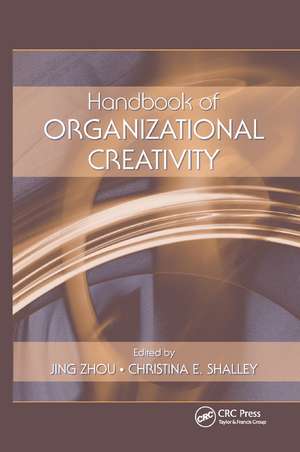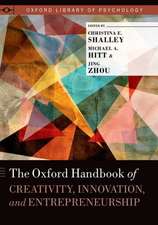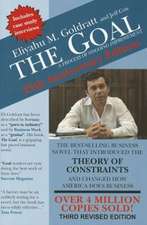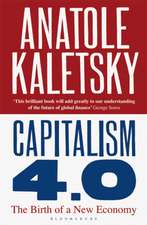Handbook of Organizational Creativity
Editat de Jing Zhou, Christina E. Shalleyen Limba Engleză Paperback – 10 dec 2019
- provides a historical review of organizational creativity theory and research
- presents critical reviews and summaries of research on micro, meso, and macro topics (e.g., leadership, feedback, goals and role expectations, groups and teams, social networks, climate and culture, deep structures, sense-making processes, and creativity and organizational change) concerning organizational creativity
- demonstrates contributions of creativity to individual work outcomes and organizational success
- discusses emerging areas and highlights promising future research trends.
Professors and graduate students in management and psychology will find this volume most beneficial. Professors and graduate students in marketing, sociology, and education also may find this book useful and relevant. Thoughtful managers and executives, professionals and knowledge workers, and aspiring managers and MBA students also would find this book beneficial in sharpening their thinking, and helping them to identify the right tools for managing creativity.
| Toate formatele și edițiile | Preț | Express |
|---|---|---|
| Paperback (1) | 442.50 lei 43-57 zile | |
| Taylor & Francis – 10 dec 2019 | 442.50 lei 43-57 zile | |
| Hardback (1) | 1009.60 lei 43-57 zile | |
| Taylor & Francis – 29 oct 2007 | 1009.60 lei 43-57 zile |
Preț: 442.50 lei
Nou
Puncte Express: 664
Preț estimativ în valută:
84.67€ • 88.64$ • 70.06£
84.67€ • 88.64$ • 70.06£
Carte tipărită la comandă
Livrare economică 07-21 aprilie
Preluare comenzi: 021 569.72.76
Specificații
ISBN-13: 9780367866655
ISBN-10: 036786665X
Pagini: 418
Dimensiuni: 152 x 229 x 18 mm
Greutate: 0.6 kg
Ediția:1
Editura: Taylor & Francis
Colecția Psychology Press
Locul publicării:Oxford, United Kingdom
ISBN-10: 036786665X
Pagini: 418
Dimensiuni: 152 x 229 x 18 mm
Greutate: 0.6 kg
Ediția:1
Editura: Taylor & Francis
Colecția Psychology Press
Locul publicării:Oxford, United Kingdom
Public țintă
ProfessionalCuprins
Section 1. Organizational Creativity in Historical Context. C. Shalley, J. Zhou, Organizational Creativity Research: An Historical Overview. T. Amabile, J. Mueller, Assessing Creativity and its Antecedents: An Exploration of the Componential Theory of Creativity. C. Ford, M. Kuenzi, Organizing Creativity Research: Insights and Proposals Suggested by Examining Classic Administrative Science Texts. Section 2. Distinctive Contributions from Organizational Creativity Research. P. Tierney, Leadership and Creativity: A Reciprocal Evolving Model. J. Zhou, Promoting Creativity through Feedback. C. Shalley, Creating Roles: What Managers Can Do to Establish Expectations for Creative Performance. P. Paulus, Fostering Creativity in Groups and Teams. J. Perry-Smith, When Being Social Facilitates Creativity: Social Networks and Creativity within Organizations. M. West, A. Richter, Climates and Cultures for Innovation and Creativity at Work. D. Dougherty, N. Tolboom, Creative Organizing to Enable Organizational Creativity: The Case of Sustained Product Innovation. R. Drazin, R. Kazanjian, M. Glynn, A Sensemaking Approach to Understanding the Politics of Creativity. R. Woodman, Creativity and Organizational Change: Linking Ideas and Extending Theory. Section 3. Normative Implications of Organizational Creativity Research. L. Gilson, Why be Creative: A Review of the Practical Outcomes Associated with Creativity at the Individual, Group, and Organizational Levels. A. Hargadon, Creativity that Works. Section 4. Suggestions for Future Organizational Creativity Research. J. Zhou, C. Shalley, Expanding the Scope and Impact of Organizational Creativity Research.
Notă biografică
Jing Zhou is Professor of Management in the Jesse H. Jones Graduate School of Management at Rice University.
Christina E. Shalley is GT Advance Professor in the College of Management at the Georgia Institute of Technology.
Christina E. Shalley is GT Advance Professor in the College of Management at the Georgia Institute of Technology.
Recenzii
"Organizational effectiveness in the 21st Century depends on innovation. Although innovation has taken on a new importance for organizations, research on innovation and its basis in creativity has received less attention. Thus Zhou and Shalley's Handbook of Creativity in Organizations is an important contribution. This book not only summarizes much of what we know about creativity it examines the variables that are the critical forces shaping creativity in organizational settings. Not only are variables influencing creativity at multiple levels, individual, group, organizational, and environmental, examined, the methods underlying this research are examined. This handbook should prove of substantial value to both those interested in studying creativity in organizations and those interested in enhancing creativity in organizational settings." - Michael Mumford, Center for Applied Social Research, The University of Oklahoma, USA
"Creativity is one of those topics that never goes out of style. Zhou and Shalley are two of the premier experts on creativity in the organizational sciences, and together they have assembled a real tour de force of contributors. Creativity is a topic that spans social science displines, each with their attendant methods and approaches. Zhou and Shalley have done a wonderful job of including scholars who draw from these diverse disciplines, including psychology and sociology, and those who employ both quantative and qualitative approaches to study creativity. Another noteworthy, and unusual, feature of the chapters in the book is that they speak to both the theoretical and applied aspects of creativity. I highly recommend this book." - Timothy A. Judge, University of Florida, USA
"Creativity is one of those topics that never goes out of style. Zhou and Shalley are two of the premier experts on creativity in the organizational sciences, and together they have assembled a real tour de force of contributors. Creativity is a topic that spans social science displines, each with their attendant methods and approaches. Zhou and Shalley have done a wonderful job of including scholars who draw from these diverse disciplines, including psychology and sociology, and those who employ both quantative and qualitative approaches to study creativity. Another noteworthy, and unusual, feature of the chapters in the book is that they speak to both the theoretical and applied aspects of creativity. I highly recommend this book." - Timothy A. Judge, University of Florida, USA











